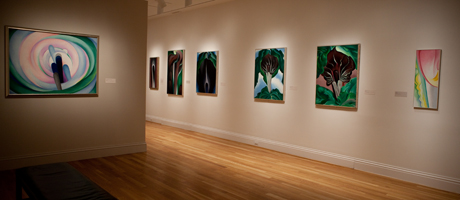An exhibition at D.C.’s Phillips Collection showcases more than a hundred works by Georgia O’Keeffe.
By Rachel Muir
While Georgia O’Keeffe may be best known for her fluid, brilliantly colored flowers, an exhibition at the Phillips Collection in Dupont Circle explores her role as an abstract artist through a wide range of her work, including charcoal drawings and sculptures.
The artwork, which spans from 1915 to 1979, “positions O’Keeffe as one of the great pioneers of abstract art,” says Dorothy Kosinski, director of the Phillips Collection. The museum has a special connection with the artist: Founder Duncan Phillips was an early patron of O’Keeffe, first purchasing her artwork in 1926. And George Washington University has its own connection to the exhibition with two graduate students involved in its development and promotion.
The exhibition begins with O’Keeffe’s early charcoal drawings, smoky whorls of black, white and gray. A simple and spiky black-and-white watercolor shows what is alternatively described as two lives swerving apart and New York City’s jagged skyline. A sculpture is said to depict the artist’s mother, who had recently died, bent over in sorrow.
O’Keeffe’s early forays into color show the sweeping blue curve of a violin, an instrument she was learning to play at the time. Her iconic flowers surface here in vivid blue, pink and yellow.
A series of photos of the artist by husband Alfred Stieglitz, a renowned American photographer in his own right, connects two galleries, the latter showcasing a masculine series of jack-in-pulpits in greens and browns on loan from the National Gallery of Art.
O’Keeffe’s late work, often far larger in scale, includes variations on a sequence of squares based on her patio steps. A wall-sized painting of lily pad-like clouds arranged on a blue background was inspired by her first flight. Watercolors done when O’Keeffe was afflicted by macular degeneration (her longtime housekeeper helped keep her brush steady) show broad brushstrokes reminiscent of Chinese characters.
“Georgia O’Keeffe’s work is an example of how artists in the early 20th century were exploring the relationship between abstraction and figuration,” says GW Assistant Professor of Art History Bibiana Obler, who is an early 20th century specialist and is working on a book about the emergence of abstract art.
“How can you convey an emotion or a sensation that you experience to another person through a painting? Is it most effective to use pure forms and colors, i.e., abstraction, or do viewers need to be able to recognize something from the ‘real world’ in order to understand --more or less -- what the artist is trying to communicate?” says Dr. Obler. “O’Keeffe struggled with these questions.”
GW Master of Art History students Jordan Amirkhani and Margaret Collerd both had behind-the-scenes roles in the exhibition. Ms. Amirkhani works as a curatorial assistant to Elsa Smithgall, curator of American art at the Phillips Collection. It’s a job that involves everything from writing and editing exhibition text panels to helping make logistical decisions about where paintings are placed and writing advertising copy.
“I am very excited to have both the experience of GW’s academic community and the professional atmosphere at the Phillips,” says Ms. Amirkhani. “Seeing how Georgia O’Keeffe’s career evolved and her work shaped over time is a great learning tool.”
Ms. Collerd develops and leads tours of the exhibition in her role as the Phillips Collection’s graduate intern for lectures and public programs. “I think Georgia O’Keeffe is a master of American painting, and this exhibition will help visitors really understand why,” says Ms. Collerd. “It’s easy to only associate Georgia O’Keeffe with flower painting and limit her to being a female artist, but through my work with the exhibition I have learned to understand her role within American modernism.
“Visitors come to the exhibition with one perspective of O’Keeffe and leave with a completely new understanding of her life’s work,” says Ms. Collerd.
The Phillips Collection is located at 1600 21st St., NW, an easy walk from GW’s Foggy Bottom Campus. Georgia O’Keeffe: Abstraction is organized by the Phillips Collection, the Whitney Museum of American Art and the Georgia O’Keeffe Museum and will be in D.C. through May 9. Adult admission is $12; students are $10.


